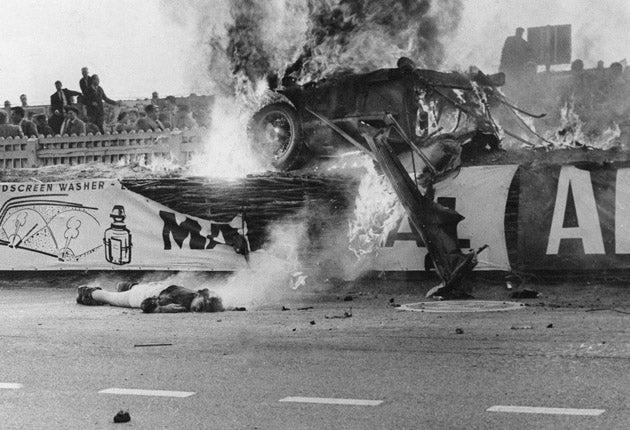The rivalry that caused the deadliest crash in motorsport
Newly found footage puts blame on British driver for a 1955 disaster that killed up to 120 at Le Mans

They had been racing for a little over two hours when it began. Pierre Levegh's Mercedes left the track, flipped on to a chest-high wattle and earth banking and spun into the old grandstand that squatted on the other side of the track from the pits.
Henri and Giselle Pasquier were among the crowd, a young couple enjoying a first outing since the birth of their baby. Behind them people were clustered on trestle tables to get a better view. They saw the car scything towards them.
"I said, 'this can't be happening – it can't fall into the crowd' and then I saw it zig-zag over people," recalled Giselle. A moment later came the impact. "The people behind... they got their heads cut off," said Henri. "A child's head had come off, right there – a head there, decapitated." He pointed at his feet.
On the track the 1955 Le Mans 24-hour race went on – in order to keep spectators from clogging the narrow roads around the circuit and hindering the removal of the dead, dying and injured. The drivers were aware that something terrible had occurred, but, under instruction, they drove on into a very dark night. Some 22 hours later Mike Hawthorn, the flamboyant British driver, claimed victory in his Jaguar. Then the blame game began.
The exact death toll has never been determined, it remains estimated at somewhere between 80 and 120, Levegh among them. It is motorsport's worst disaster. For years Levegh, the veteran French driver, has been seen as the one at fault – the cause, rather than a victim, of the tragedy.
The makers of a documentary exploring the tragedy, to be shown on TV for the first time tomorrow, have reconstructed a roll of film taken by a spectator, who was himself injured. It has not been seen for over half a century and it serves to dramatically shift the blame. For John Fitch, Levegh's co-driver, there has never been any doubt. "Hawthorn by my evidence, the things that I saw and heard and knew from this event, caused the accident," said Fitch, now 92.
The 1955 race was dominated by the duel between Mercedes and Jaguar. The German team was led by the legendary Juan Fangio – "El Maestro", Jaguar by Hawthorn. There was an edge though to the rivalry – Hawthorn, a 26-year-old blond-haired former public schoolboy, made no secret of a loathing of all things German.
Jacques Grelley, who later became a racing driver, was watching from the stands in disbelief as the race developed. "He brutalised the car," he said. "Hawthorn never accepted that a German car could pass a British car."
It was on lap 35 that disaster struck. As the reconstructed footage shows, Hawthorn and Fangio prepared to lap Levegh with the Austin-Healey of Lance Macklin there too. Hawthorn overtook Macklin and slowed as he readied himself to refuel at the fast-approaching pits. Macklin swerved, possibly as a result of his brakes locking. Levegh could do nothing to avoid him and Macklin's car effectively turned into a ramp for Levegh's. The footage clearly exonerates the Austin-Healey driver; instead it is the rashness of Hawthorn's driving that stands out. "Did Hawthorn have to pull in like that?" says John Matthews, the documentary's producer.
As the terrible events unfolded, Fitch saw Hawthorn come in for the change around. "Hawthorn was a broken man," he said. "Tears and agony and a mistake that he's just made that has caused the death of innocent people by the scores, that breaks men and that broke Mike Hawthorn." But by the time Hawthorn crossed the finish line – Mercedes pulled out of the race – his attitude had changed. He denied it was any of his doing, instead he pointed the finger at Macklin.
A secretive inquiry cleared Jaguar of any fault. Hawthorn went on to win the Formula One world championship in 1958 but retired immediately afterwards. A year later he was dead, killed after crashing his Jaguar as he tried to overtake on the A3 near his Surrey home. The car he was trying to pass was a Mercedes.
Deadliest Crash is on BBC4 on Sunday at 9pm. www.big-pic.co.uk
Join our commenting forum
Join thought-provoking conversations, follow other Independent readers and see their replies
Comments
Bookmark popover
Removed from bookmarks